Financial Analysis: Leighton Holdings Limited Impairment Assessment
VerifiedAdded on 2020/05/28
|8
|2855
|29
Report
AI Summary
This report provides a comprehensive analysis of the impairment testing procedures employed by Leighton Holdings Limited, focusing on the financial year ending December 31, 2016. The analysis covers the impairment of various assets, including property, plant, and equipment, intangible assets (specifically goodwill), and trade debtors, as detailed in the company's annual report. The report examines the methodologies used, such as the identification of cash-generating units, the determination of recoverable amounts (value in use and net selling price), and the key assumptions considered, including market growth, commodity prices, inflation rates, discount rates, and growth rates. Furthermore, the report discusses the subjectivity inherent in the impairment testing process, particularly concerning the valuation of assets and the impact on the company's net worth. The analysis also delves into the application of Australian Accounting Standards (AASB) 136 and the fair value measurement principles. Finally, the report explores the implications of accounting standards on lease treatments, and the economic realities of financial statements, referencing the role of IASB and the impact of lease accounting on balance sheets and financial decision-making.
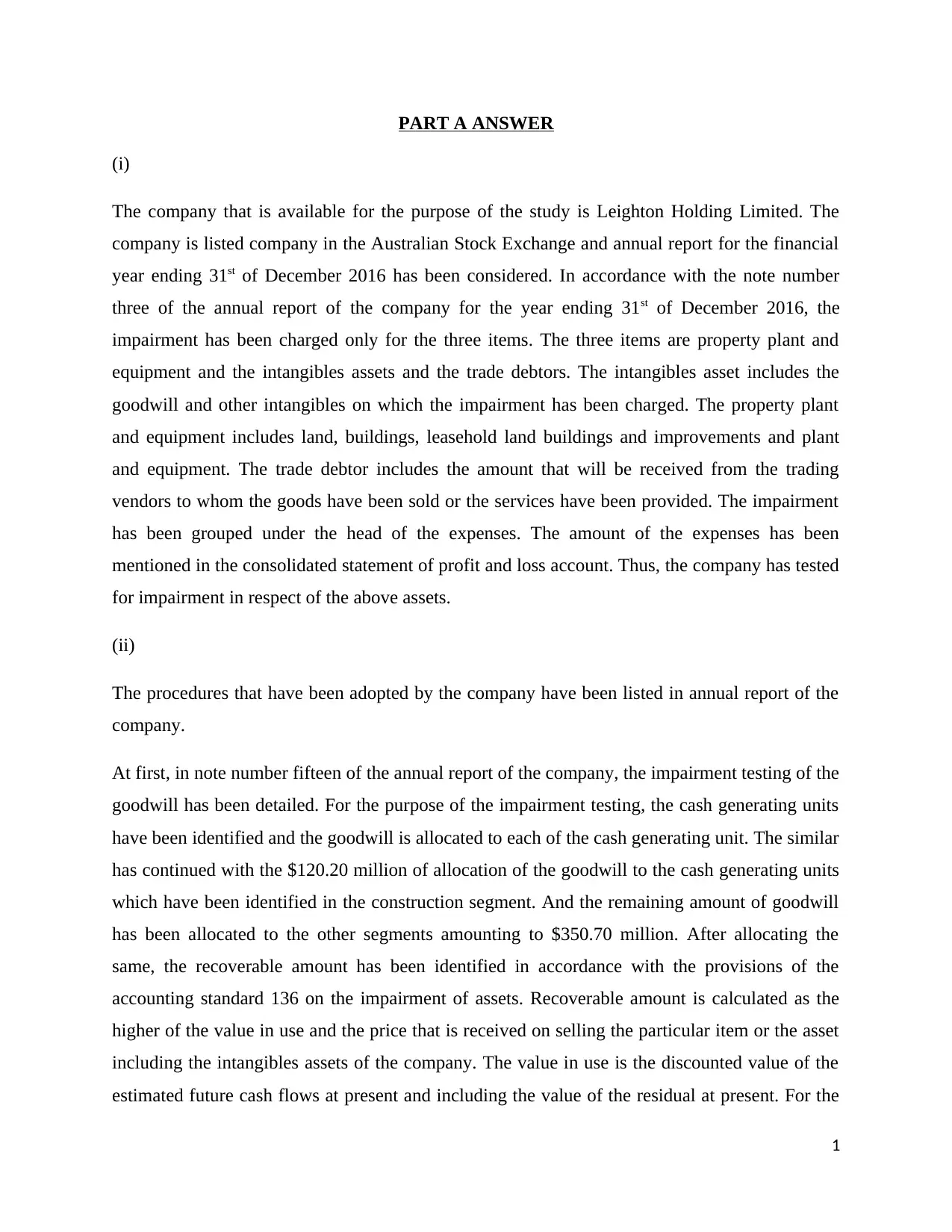
PART A ANSWER
(i)
The company that is available for the purpose of the study is Leighton Holding Limited. The
company is listed company in the Australian Stock Exchange and annual report for the financial
year ending 31st of December 2016 has been considered. In accordance with the note number
three of the annual report of the company for the year ending 31st of December 2016, the
impairment has been charged only for the three items. The three items are property plant and
equipment and the intangibles assets and the trade debtors. The intangibles asset includes the
goodwill and other intangibles on which the impairment has been charged. The property plant
and equipment includes land, buildings, leasehold land buildings and improvements and plant
and equipment. The trade debtor includes the amount that will be received from the trading
vendors to whom the goods have been sold or the services have been provided. The impairment
has been grouped under the head of the expenses. The amount of the expenses has been
mentioned in the consolidated statement of profit and loss account. Thus, the company has tested
for impairment in respect of the above assets.
(ii)
The procedures that have been adopted by the company have been listed in annual report of the
company.
At first, in note number fifteen of the annual report of the company, the impairment testing of the
goodwill has been detailed. For the purpose of the impairment testing, the cash generating units
have been identified and the goodwill is allocated to each of the cash generating unit. The similar
has continued with the $120.20 million of allocation of the goodwill to the cash generating units
which have been identified in the construction segment. And the remaining amount of goodwill
has been allocated to the other segments amounting to $350.70 million. After allocating the
same, the recoverable amount has been identified in accordance with the provisions of the
accounting standard 136 on the impairment of assets. Recoverable amount is calculated as the
higher of the value in use and the price that is received on selling the particular item or the asset
including the intangibles assets of the company. The value in use is the discounted value of the
estimated future cash flows at present and including the value of the residual at present. For the
1
(i)
The company that is available for the purpose of the study is Leighton Holding Limited. The
company is listed company in the Australian Stock Exchange and annual report for the financial
year ending 31st of December 2016 has been considered. In accordance with the note number
three of the annual report of the company for the year ending 31st of December 2016, the
impairment has been charged only for the three items. The three items are property plant and
equipment and the intangibles assets and the trade debtors. The intangibles asset includes the
goodwill and other intangibles on which the impairment has been charged. The property plant
and equipment includes land, buildings, leasehold land buildings and improvements and plant
and equipment. The trade debtor includes the amount that will be received from the trading
vendors to whom the goods have been sold or the services have been provided. The impairment
has been grouped under the head of the expenses. The amount of the expenses has been
mentioned in the consolidated statement of profit and loss account. Thus, the company has tested
for impairment in respect of the above assets.
(ii)
The procedures that have been adopted by the company have been listed in annual report of the
company.
At first, in note number fifteen of the annual report of the company, the impairment testing of the
goodwill has been detailed. For the purpose of the impairment testing, the cash generating units
have been identified and the goodwill is allocated to each of the cash generating unit. The similar
has continued with the $120.20 million of allocation of the goodwill to the cash generating units
which have been identified in the construction segment. And the remaining amount of goodwill
has been allocated to the other segments amounting to $350.70 million. After allocating the
same, the recoverable amount has been identified in accordance with the provisions of the
accounting standard 136 on the impairment of assets. Recoverable amount is calculated as the
higher of the value in use and the price that is received on selling the particular item or the asset
including the intangibles assets of the company. The value in use is the discounted value of the
estimated future cash flows at present and including the value of the residual at present. For the
1
Paraphrase This Document
Need a fresh take? Get an instant paraphrase of this document with our AI Paraphraser
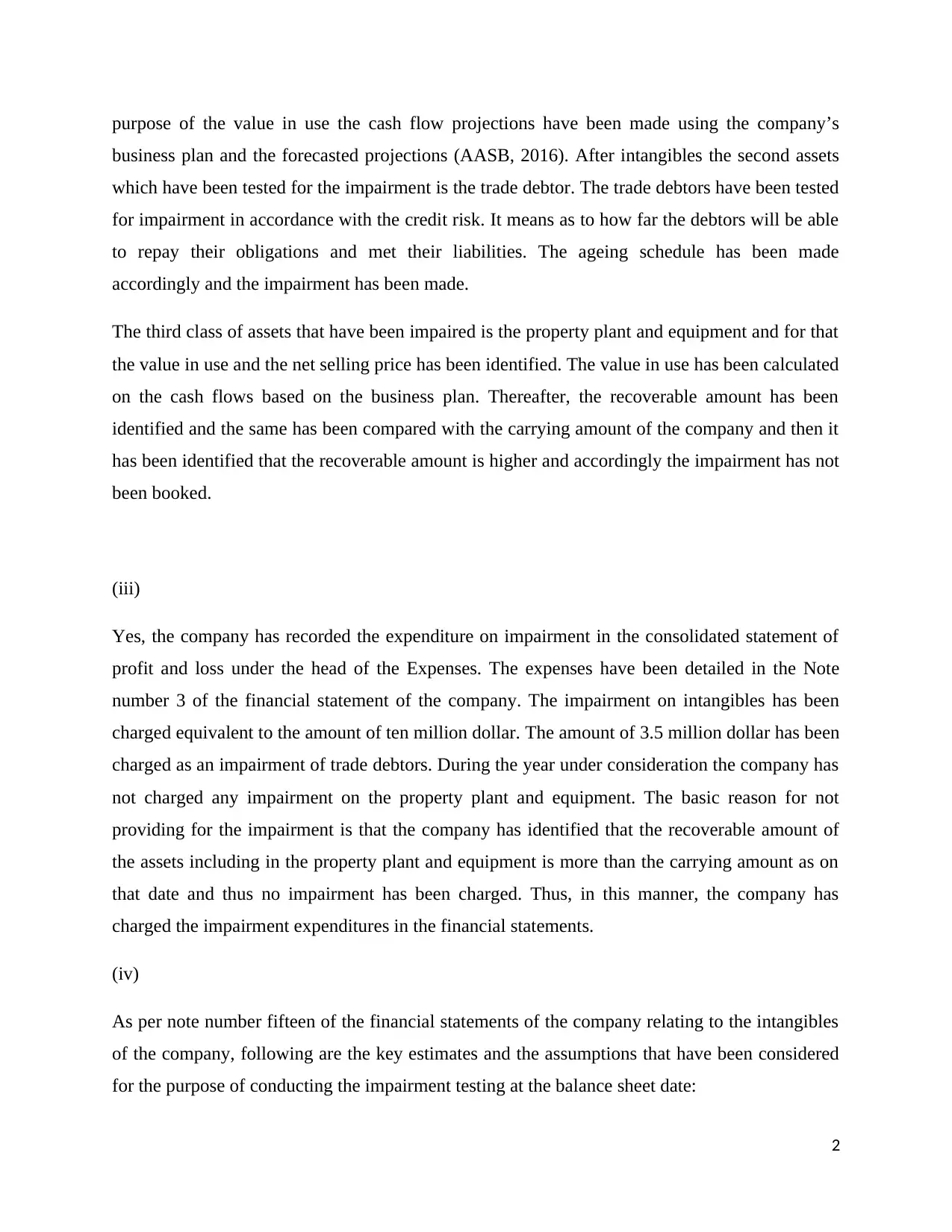
purpose of the value in use the cash flow projections have been made using the company’s
business plan and the forecasted projections (AASB, 2016). After intangibles the second assets
which have been tested for the impairment is the trade debtor. The trade debtors have been tested
for impairment in accordance with the credit risk. It means as to how far the debtors will be able
to repay their obligations and met their liabilities. The ageing schedule has been made
accordingly and the impairment has been made.
The third class of assets that have been impaired is the property plant and equipment and for that
the value in use and the net selling price has been identified. The value in use has been calculated
on the cash flows based on the business plan. Thereafter, the recoverable amount has been
identified and the same has been compared with the carrying amount of the company and then it
has been identified that the recoverable amount is higher and accordingly the impairment has not
been booked.
(iii)
Yes, the company has recorded the expenditure on impairment in the consolidated statement of
profit and loss under the head of the Expenses. The expenses have been detailed in the Note
number 3 of the financial statement of the company. The impairment on intangibles has been
charged equivalent to the amount of ten million dollar. The amount of 3.5 million dollar has been
charged as an impairment of trade debtors. During the year under consideration the company has
not charged any impairment on the property plant and equipment. The basic reason for not
providing for the impairment is that the company has identified that the recoverable amount of
the assets including in the property plant and equipment is more than the carrying amount as on
that date and thus no impairment has been charged. Thus, in this manner, the company has
charged the impairment expenditures in the financial statements.
(iv)
As per note number fifteen of the financial statements of the company relating to the intangibles
of the company, following are the key estimates and the assumptions that have been considered
for the purpose of conducting the impairment testing at the balance sheet date:
2
business plan and the forecasted projections (AASB, 2016). After intangibles the second assets
which have been tested for the impairment is the trade debtor. The trade debtors have been tested
for impairment in accordance with the credit risk. It means as to how far the debtors will be able
to repay their obligations and met their liabilities. The ageing schedule has been made
accordingly and the impairment has been made.
The third class of assets that have been impaired is the property plant and equipment and for that
the value in use and the net selling price has been identified. The value in use has been calculated
on the cash flows based on the business plan. Thereafter, the recoverable amount has been
identified and the same has been compared with the carrying amount of the company and then it
has been identified that the recoverable amount is higher and accordingly the impairment has not
been booked.
(iii)
Yes, the company has recorded the expenditure on impairment in the consolidated statement of
profit and loss under the head of the Expenses. The expenses have been detailed in the Note
number 3 of the financial statement of the company. The impairment on intangibles has been
charged equivalent to the amount of ten million dollar. The amount of 3.5 million dollar has been
charged as an impairment of trade debtors. During the year under consideration the company has
not charged any impairment on the property plant and equipment. The basic reason for not
providing for the impairment is that the company has identified that the recoverable amount of
the assets including in the property plant and equipment is more than the carrying amount as on
that date and thus no impairment has been charged. Thus, in this manner, the company has
charged the impairment expenditures in the financial statements.
(iv)
As per note number fifteen of the financial statements of the company relating to the intangibles
of the company, following are the key estimates and the assumptions that have been considered
for the purpose of conducting the impairment testing at the balance sheet date:
2
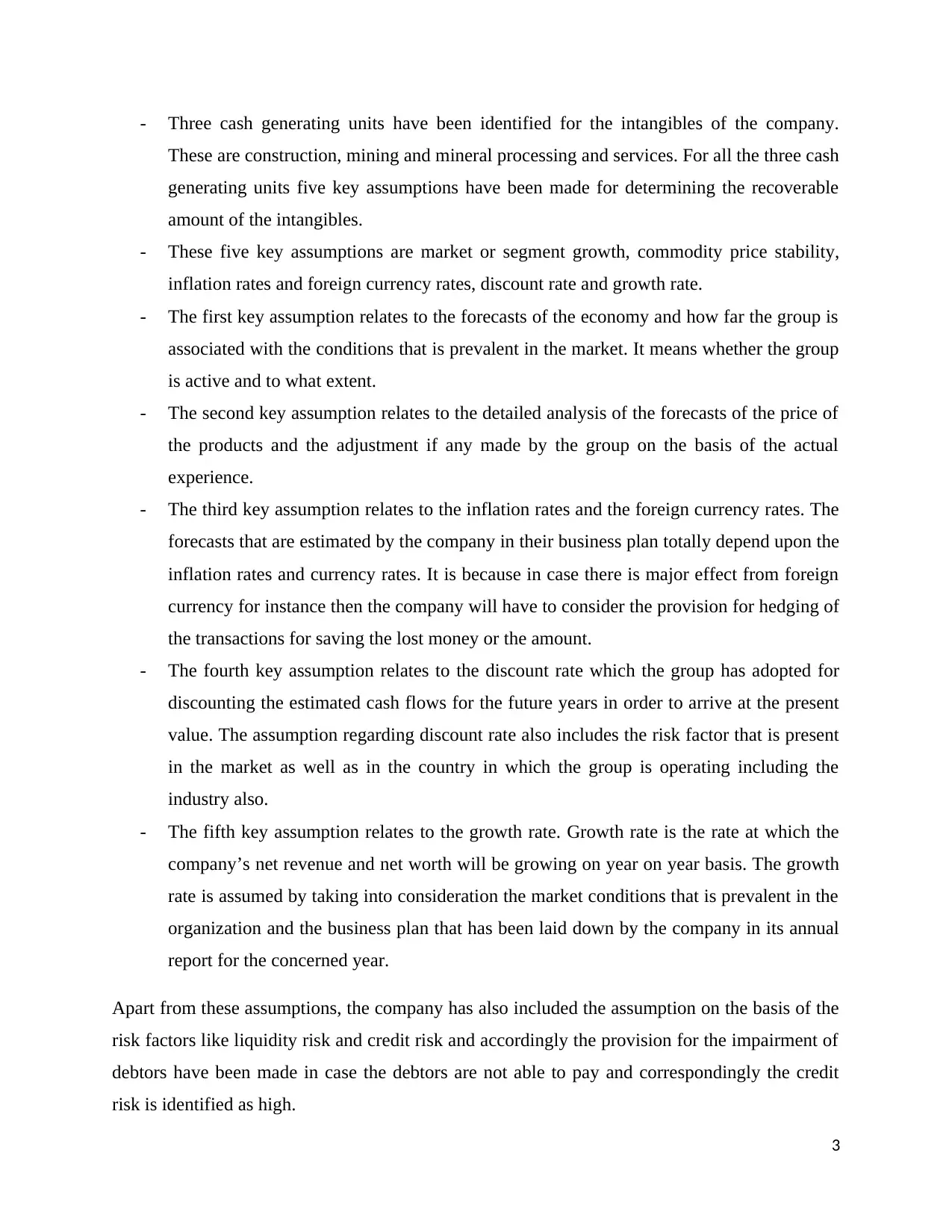
- Three cash generating units have been identified for the intangibles of the company.
These are construction, mining and mineral processing and services. For all the three cash
generating units five key assumptions have been made for determining the recoverable
amount of the intangibles.
- These five key assumptions are market or segment growth, commodity price stability,
inflation rates and foreign currency rates, discount rate and growth rate.
- The first key assumption relates to the forecasts of the economy and how far the group is
associated with the conditions that is prevalent in the market. It means whether the group
is active and to what extent.
- The second key assumption relates to the detailed analysis of the forecasts of the price of
the products and the adjustment if any made by the group on the basis of the actual
experience.
- The third key assumption relates to the inflation rates and the foreign currency rates. The
forecasts that are estimated by the company in their business plan totally depend upon the
inflation rates and currency rates. It is because in case there is major effect from foreign
currency for instance then the company will have to consider the provision for hedging of
the transactions for saving the lost money or the amount.
- The fourth key assumption relates to the discount rate which the group has adopted for
discounting the estimated cash flows for the future years in order to arrive at the present
value. The assumption regarding discount rate also includes the risk factor that is present
in the market as well as in the country in which the group is operating including the
industry also.
- The fifth key assumption relates to the growth rate. Growth rate is the rate at which the
company’s net revenue and net worth will be growing on year on year basis. The growth
rate is assumed by taking into consideration the market conditions that is prevalent in the
organization and the business plan that has been laid down by the company in its annual
report for the concerned year.
Apart from these assumptions, the company has also included the assumption on the basis of the
risk factors like liquidity risk and credit risk and accordingly the provision for the impairment of
debtors have been made in case the debtors are not able to pay and correspondingly the credit
risk is identified as high.
3
These are construction, mining and mineral processing and services. For all the three cash
generating units five key assumptions have been made for determining the recoverable
amount of the intangibles.
- These five key assumptions are market or segment growth, commodity price stability,
inflation rates and foreign currency rates, discount rate and growth rate.
- The first key assumption relates to the forecasts of the economy and how far the group is
associated with the conditions that is prevalent in the market. It means whether the group
is active and to what extent.
- The second key assumption relates to the detailed analysis of the forecasts of the price of
the products and the adjustment if any made by the group on the basis of the actual
experience.
- The third key assumption relates to the inflation rates and the foreign currency rates. The
forecasts that are estimated by the company in their business plan totally depend upon the
inflation rates and currency rates. It is because in case there is major effect from foreign
currency for instance then the company will have to consider the provision for hedging of
the transactions for saving the lost money or the amount.
- The fourth key assumption relates to the discount rate which the group has adopted for
discounting the estimated cash flows for the future years in order to arrive at the present
value. The assumption regarding discount rate also includes the risk factor that is present
in the market as well as in the country in which the group is operating including the
industry also.
- The fifth key assumption relates to the growth rate. Growth rate is the rate at which the
company’s net revenue and net worth will be growing on year on year basis. The growth
rate is assumed by taking into consideration the market conditions that is prevalent in the
organization and the business plan that has been laid down by the company in its annual
report for the concerned year.
Apart from these assumptions, the company has also included the assumption on the basis of the
risk factors like liquidity risk and credit risk and accordingly the provision for the impairment of
debtors have been made in case the debtors are not able to pay and correspondingly the credit
risk is identified as high.
3
⊘ This is a preview!⊘
Do you want full access?
Subscribe today to unlock all pages.

Trusted by 1+ million students worldwide
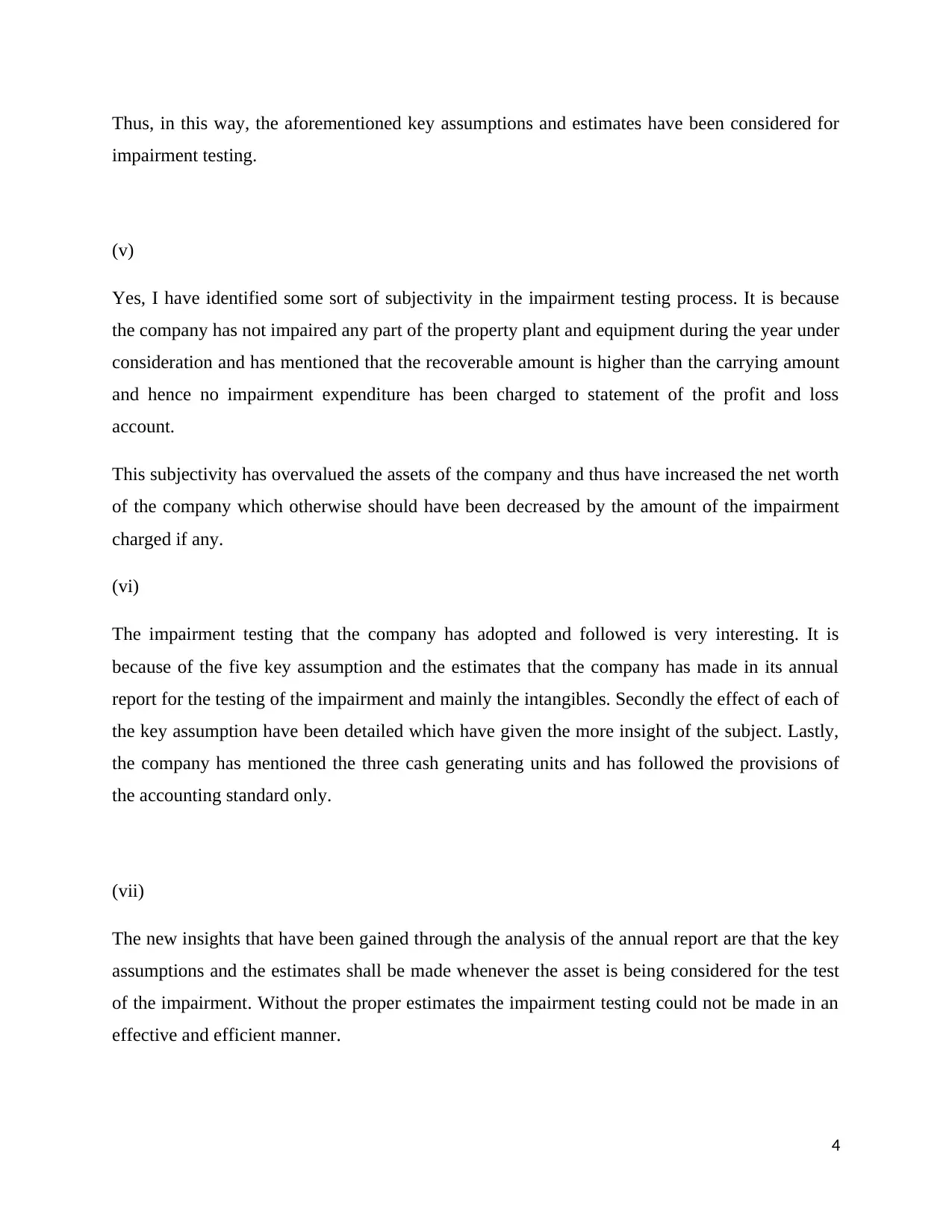
Thus, in this way, the aforementioned key assumptions and estimates have been considered for
impairment testing.
(v)
Yes, I have identified some sort of subjectivity in the impairment testing process. It is because
the company has not impaired any part of the property plant and equipment during the year under
consideration and has mentioned that the recoverable amount is higher than the carrying amount
and hence no impairment expenditure has been charged to statement of the profit and loss
account.
This subjectivity has overvalued the assets of the company and thus have increased the net worth
of the company which otherwise should have been decreased by the amount of the impairment
charged if any.
(vi)
The impairment testing that the company has adopted and followed is very interesting. It is
because of the five key assumption and the estimates that the company has made in its annual
report for the testing of the impairment and mainly the intangibles. Secondly the effect of each of
the key assumption have been detailed which have given the more insight of the subject. Lastly,
the company has mentioned the three cash generating units and has followed the provisions of
the accounting standard only.
(vii)
The new insights that have been gained through the analysis of the annual report are that the key
assumptions and the estimates shall be made whenever the asset is being considered for the test
of the impairment. Without the proper estimates the impairment testing could not be made in an
effective and efficient manner.
4
impairment testing.
(v)
Yes, I have identified some sort of subjectivity in the impairment testing process. It is because
the company has not impaired any part of the property plant and equipment during the year under
consideration and has mentioned that the recoverable amount is higher than the carrying amount
and hence no impairment expenditure has been charged to statement of the profit and loss
account.
This subjectivity has overvalued the assets of the company and thus have increased the net worth
of the company which otherwise should have been decreased by the amount of the impairment
charged if any.
(vi)
The impairment testing that the company has adopted and followed is very interesting. It is
because of the five key assumption and the estimates that the company has made in its annual
report for the testing of the impairment and mainly the intangibles. Secondly the effect of each of
the key assumption have been detailed which have given the more insight of the subject. Lastly,
the company has mentioned the three cash generating units and has followed the provisions of
the accounting standard only.
(vii)
The new insights that have been gained through the analysis of the annual report are that the key
assumptions and the estimates shall be made whenever the asset is being considered for the test
of the impairment. Without the proper estimates the impairment testing could not be made in an
effective and efficient manner.
4
Paraphrase This Document
Need a fresh take? Get an instant paraphrase of this document with our AI Paraphraser
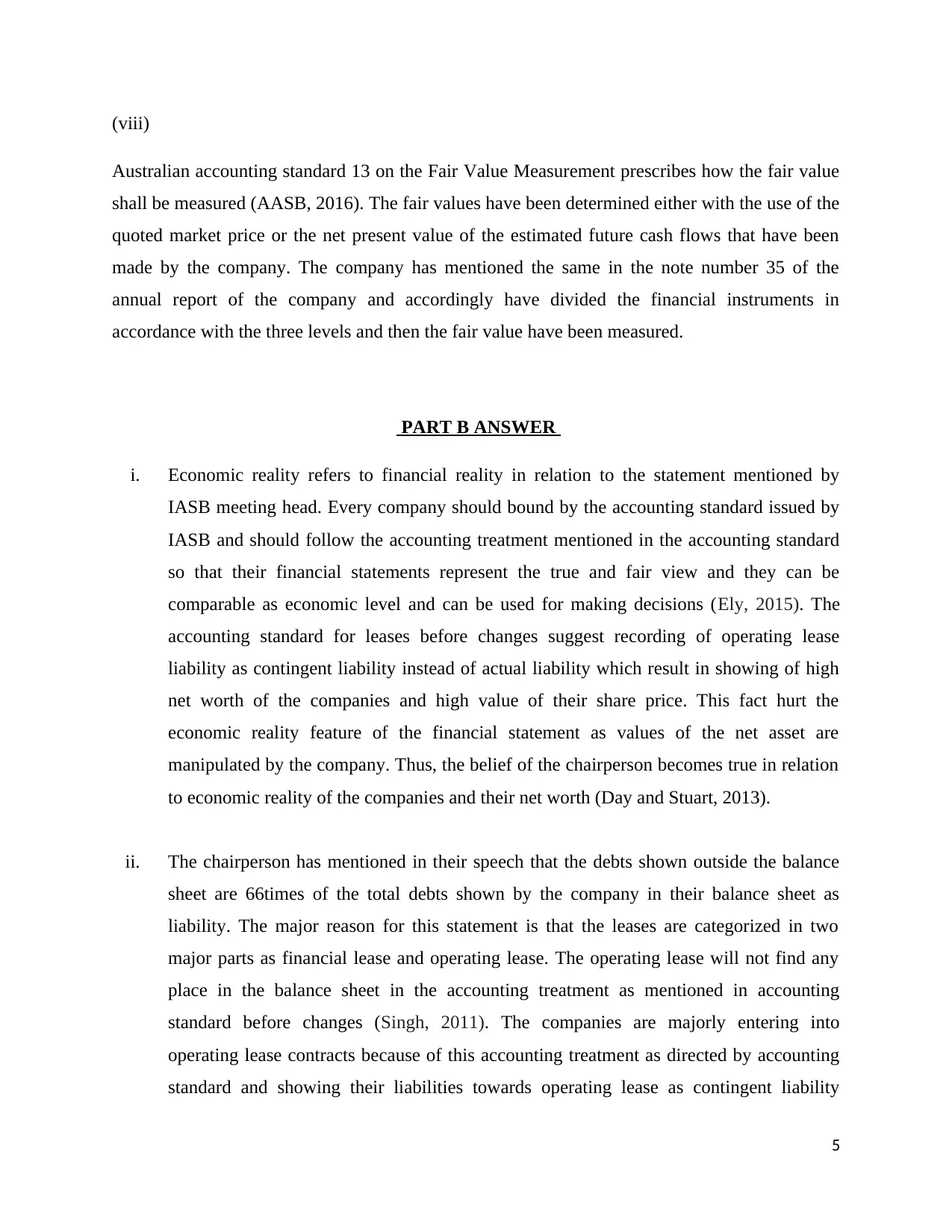
(viii)
Australian accounting standard 13 on the Fair Value Measurement prescribes how the fair value
shall be measured (AASB, 2016). The fair values have been determined either with the use of the
quoted market price or the net present value of the estimated future cash flows that have been
made by the company. The company has mentioned the same in the note number 35 of the
annual report of the company and accordingly have divided the financial instruments in
accordance with the three levels and then the fair value have been measured.
PART B ANSWER
i. Economic reality refers to financial reality in relation to the statement mentioned by
IASB meeting head. Every company should bound by the accounting standard issued by
IASB and should follow the accounting treatment mentioned in the accounting standard
so that their financial statements represent the true and fair view and they can be
comparable as economic level and can be used for making decisions (Ely, 2015). The
accounting standard for leases before changes suggest recording of operating lease
liability as contingent liability instead of actual liability which result in showing of high
net worth of the companies and high value of their share price. This fact hurt the
economic reality feature of the financial statement as values of the net asset are
manipulated by the company. Thus, the belief of the chairperson becomes true in relation
to economic reality of the companies and their net worth (Day and Stuart, 2013).
ii. The chairperson has mentioned in their speech that the debts shown outside the balance
sheet are 66times of the total debts shown by the company in their balance sheet as
liability. The major reason for this statement is that the leases are categorized in two
major parts as financial lease and operating lease. The operating lease will not find any
place in the balance sheet in the accounting treatment as mentioned in accounting
standard before changes (Singh, 2011). The companies are majorly entering into
operating lease contracts because of this accounting treatment as directed by accounting
standard and showing their liabilities towards operating lease as contingent liability
5
Australian accounting standard 13 on the Fair Value Measurement prescribes how the fair value
shall be measured (AASB, 2016). The fair values have been determined either with the use of the
quoted market price or the net present value of the estimated future cash flows that have been
made by the company. The company has mentioned the same in the note number 35 of the
annual report of the company and accordingly have divided the financial instruments in
accordance with the three levels and then the fair value have been measured.
PART B ANSWER
i. Economic reality refers to financial reality in relation to the statement mentioned by
IASB meeting head. Every company should bound by the accounting standard issued by
IASB and should follow the accounting treatment mentioned in the accounting standard
so that their financial statements represent the true and fair view and they can be
comparable as economic level and can be used for making decisions (Ely, 2015). The
accounting standard for leases before changes suggest recording of operating lease
liability as contingent liability instead of actual liability which result in showing of high
net worth of the companies and high value of their share price. This fact hurt the
economic reality feature of the financial statement as values of the net asset are
manipulated by the company. Thus, the belief of the chairperson becomes true in relation
to economic reality of the companies and their net worth (Day and Stuart, 2013).
ii. The chairperson has mentioned in their speech that the debts shown outside the balance
sheet are 66times of the total debts shown by the company in their balance sheet as
liability. The major reason for this statement is that the leases are categorized in two
major parts as financial lease and operating lease. The operating lease will not find any
place in the balance sheet in the accounting treatment as mentioned in accounting
standard before changes (Singh, 2011). The companies are majorly entering into
operating lease contracts because of this accounting treatment as directed by accounting
standard and showing their liabilities towards operating lease as contingent liability
5
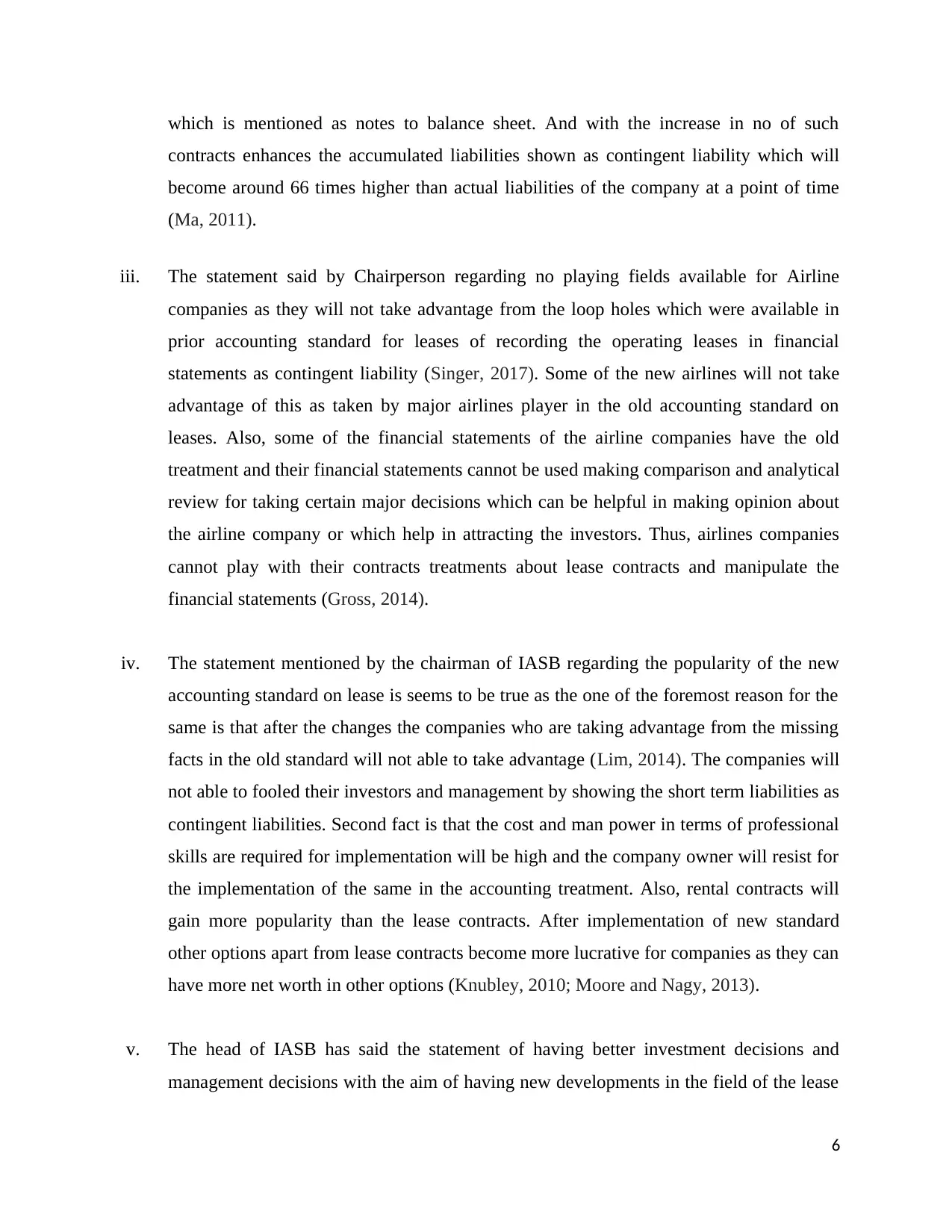
which is mentioned as notes to balance sheet. And with the increase in no of such
contracts enhances the accumulated liabilities shown as contingent liability which will
become around 66 times higher than actual liabilities of the company at a point of time
(Ma, 2011).
iii. The statement said by Chairperson regarding no playing fields available for Airline
companies as they will not take advantage from the loop holes which were available in
prior accounting standard for leases of recording the operating leases in financial
statements as contingent liability (Singer, 2017). Some of the new airlines will not take
advantage of this as taken by major airlines player in the old accounting standard on
leases. Also, some of the financial statements of the airline companies have the old
treatment and their financial statements cannot be used making comparison and analytical
review for taking certain major decisions which can be helpful in making opinion about
the airline company or which help in attracting the investors. Thus, airlines companies
cannot play with their contracts treatments about lease contracts and manipulate the
financial statements (Gross, 2014).
iv. The statement mentioned by the chairman of IASB regarding the popularity of the new
accounting standard on lease is seems to be true as the one of the foremost reason for the
same is that after the changes the companies who are taking advantage from the missing
facts in the old standard will not able to take advantage (Lim, 2014). The companies will
not able to fooled their investors and management by showing the short term liabilities as
contingent liabilities. Second fact is that the cost and man power in terms of professional
skills are required for implementation will be high and the company owner will resist for
the implementation of the same in the accounting treatment. Also, rental contracts will
gain more popularity than the lease contracts. After implementation of new standard
other options apart from lease contracts become more lucrative for companies as they can
have more net worth in other options (Knubley, 2010; Moore and Nagy, 2013).
v. The head of IASB has said the statement of having better investment decisions and
management decisions with the aim of having new developments in the field of the lease
6
contracts enhances the accumulated liabilities shown as contingent liability which will
become around 66 times higher than actual liabilities of the company at a point of time
(Ma, 2011).
iii. The statement said by Chairperson regarding no playing fields available for Airline
companies as they will not take advantage from the loop holes which were available in
prior accounting standard for leases of recording the operating leases in financial
statements as contingent liability (Singer, 2017). Some of the new airlines will not take
advantage of this as taken by major airlines player in the old accounting standard on
leases. Also, some of the financial statements of the airline companies have the old
treatment and their financial statements cannot be used making comparison and analytical
review for taking certain major decisions which can be helpful in making opinion about
the airline company or which help in attracting the investors. Thus, airlines companies
cannot play with their contracts treatments about lease contracts and manipulate the
financial statements (Gross, 2014).
iv. The statement mentioned by the chairman of IASB regarding the popularity of the new
accounting standard on lease is seems to be true as the one of the foremost reason for the
same is that after the changes the companies who are taking advantage from the missing
facts in the old standard will not able to take advantage (Lim, 2014). The companies will
not able to fooled their investors and management by showing the short term liabilities as
contingent liabilities. Second fact is that the cost and man power in terms of professional
skills are required for implementation will be high and the company owner will resist for
the implementation of the same in the accounting treatment. Also, rental contracts will
gain more popularity than the lease contracts. After implementation of new standard
other options apart from lease contracts become more lucrative for companies as they can
have more net worth in other options (Knubley, 2010; Moore and Nagy, 2013).
v. The head of IASB has said the statement of having better investment decisions and
management decisions with the aim of having new developments in the field of the lease
6
⊘ This is a preview!⊘
Do you want full access?
Subscribe today to unlock all pages.

Trusted by 1+ million students worldwide
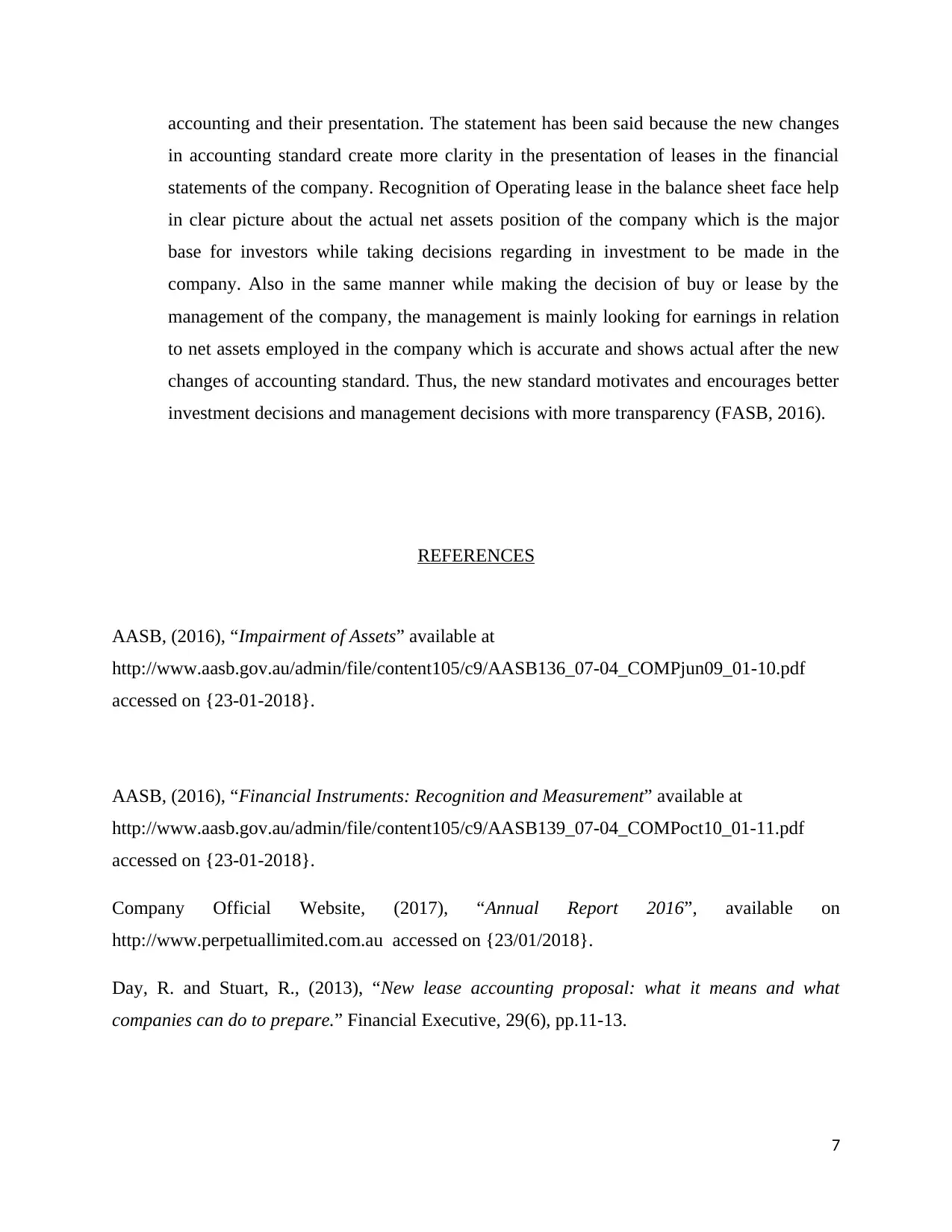
accounting and their presentation. The statement has been said because the new changes
in accounting standard create more clarity in the presentation of leases in the financial
statements of the company. Recognition of Operating lease in the balance sheet face help
in clear picture about the actual net assets position of the company which is the major
base for investors while taking decisions regarding in investment to be made in the
company. Also in the same manner while making the decision of buy or lease by the
management of the company, the management is mainly looking for earnings in relation
to net assets employed in the company which is accurate and shows actual after the new
changes of accounting standard. Thus, the new standard motivates and encourages better
investment decisions and management decisions with more transparency (FASB, 2016).
REFERENCES
AASB, (2016), “Impairment of Assets” available at
http://www.aasb.gov.au/admin/file/content105/c9/AASB136_07-04_COMPjun09_01-10.pdf
accessed on {23-01-2018}.
AASB, (2016), “Financial Instruments: Recognition and Measurement” available at
http://www.aasb.gov.au/admin/file/content105/c9/AASB139_07-04_COMPoct10_01-11.pdf
accessed on {23-01-2018}.
Company Official Website, (2017), “Annual Report 2016”, available on
http://www.perpetuallimited.com.au accessed on {23/01/2018}.
Day, R. and Stuart, R., (2013), “New lease accounting proposal: what it means and what
companies can do to prepare.” Financial Executive, 29(6), pp.11-13.
7
in accounting standard create more clarity in the presentation of leases in the financial
statements of the company. Recognition of Operating lease in the balance sheet face help
in clear picture about the actual net assets position of the company which is the major
base for investors while taking decisions regarding in investment to be made in the
company. Also in the same manner while making the decision of buy or lease by the
management of the company, the management is mainly looking for earnings in relation
to net assets employed in the company which is accurate and shows actual after the new
changes of accounting standard. Thus, the new standard motivates and encourages better
investment decisions and management decisions with more transparency (FASB, 2016).
REFERENCES
AASB, (2016), “Impairment of Assets” available at
http://www.aasb.gov.au/admin/file/content105/c9/AASB136_07-04_COMPjun09_01-10.pdf
accessed on {23-01-2018}.
AASB, (2016), “Financial Instruments: Recognition and Measurement” available at
http://www.aasb.gov.au/admin/file/content105/c9/AASB139_07-04_COMPoct10_01-11.pdf
accessed on {23-01-2018}.
Company Official Website, (2017), “Annual Report 2016”, available on
http://www.perpetuallimited.com.au accessed on {23/01/2018}.
Day, R. and Stuart, R., (2013), “New lease accounting proposal: what it means and what
companies can do to prepare.” Financial Executive, 29(6), pp.11-13.
7
Paraphrase This Document
Need a fresh take? Get an instant paraphrase of this document with our AI Paraphraser
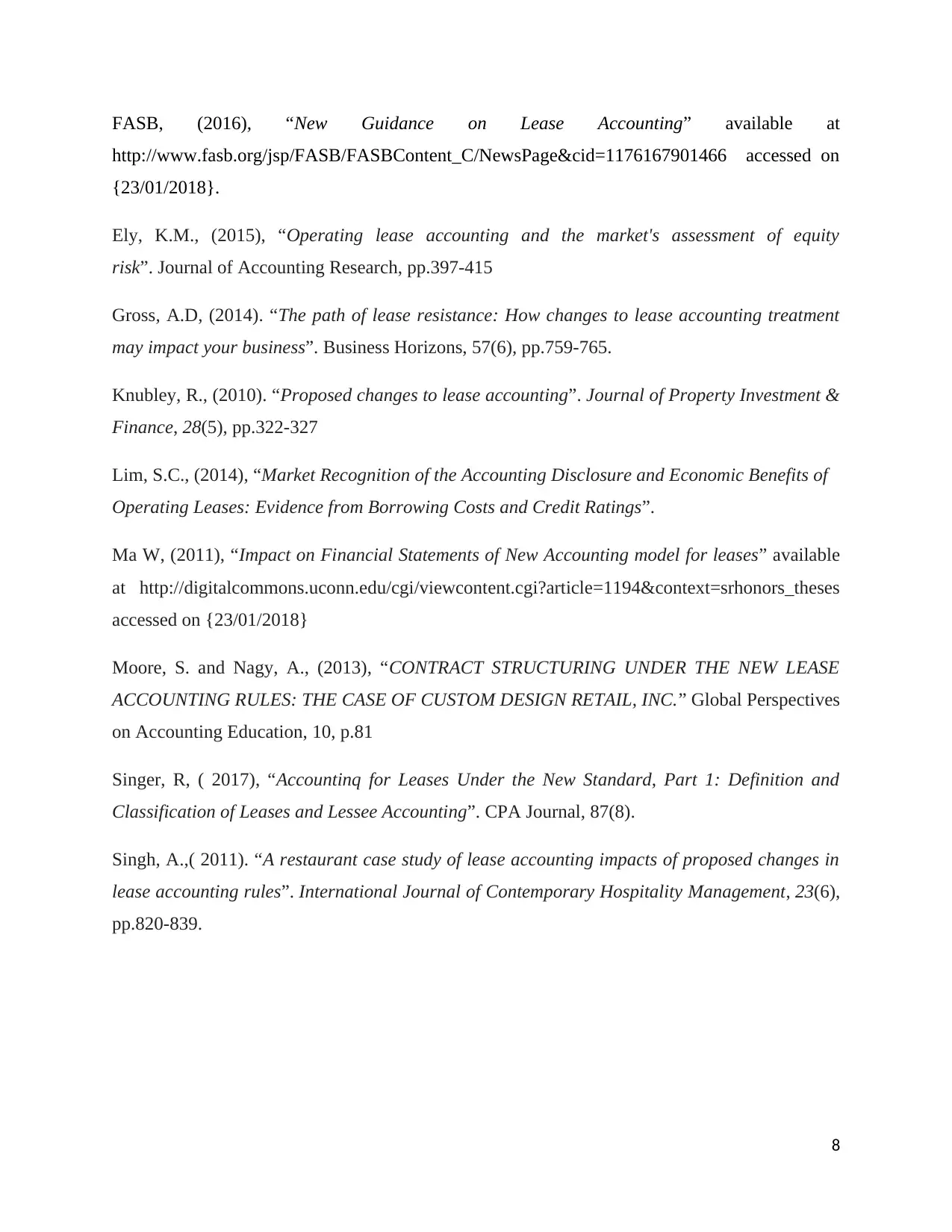
FASB, (2016), “New Guidance on Lease Accounting” available at
http://www.fasb.org/jsp/FASB/FASBContent_C/NewsPage&cid=1176167901466 accessed on
{23/01/2018}.
Ely, K.M., (2015), “Operating lease accounting and the market's assessment of equity
risk”. Journal of Accounting Research, pp.397-415
Gross, A.D, (2014). “The path of lease resistance: How changes to lease accounting treatment
may impact your business”. Business Horizons, 57(6), pp.759-765.
Knubley, R., (2010). “Proposed changes to lease accounting”. Journal of Property Investment &
Finance, 28(5), pp.322-327
Lim, S.C., (2014), “Market Recognition of the Accounting Disclosure and Economic Benefits of
Operating Leases: Evidence from Borrowing Costs and Credit Ratings”.
Ma W, (2011), “Impact on Financial Statements of New Accounting model for leases” available
at http://digitalcommons.uconn.edu/cgi/viewcontent.cgi?article=1194&context=srhonors_theses
accessed on {23/01/2018}
Moore, S. and Nagy, A., (2013), “CONTRACT STRUCTURING UNDER THE NEW LEASE
ACCOUNTING RULES: THE CASE OF CUSTOM DESIGN RETAIL, INC.” Global Perspectives
on Accounting Education, 10, p.81
Singer, R, ( 2017), “Accountinq for Leases Under the New Standard, Part 1: Definition and
Classification of Leases and Lessee Accounting”. CPA Journal, 87(8).
Singh, A.,( 2011). “A restaurant case study of lease accounting impacts of proposed changes in
lease accounting rules”. International Journal of Contemporary Hospitality Management, 23(6),
pp.820-839.
8
http://www.fasb.org/jsp/FASB/FASBContent_C/NewsPage&cid=1176167901466 accessed on
{23/01/2018}.
Ely, K.M., (2015), “Operating lease accounting and the market's assessment of equity
risk”. Journal of Accounting Research, pp.397-415
Gross, A.D, (2014). “The path of lease resistance: How changes to lease accounting treatment
may impact your business”. Business Horizons, 57(6), pp.759-765.
Knubley, R., (2010). “Proposed changes to lease accounting”. Journal of Property Investment &
Finance, 28(5), pp.322-327
Lim, S.C., (2014), “Market Recognition of the Accounting Disclosure and Economic Benefits of
Operating Leases: Evidence from Borrowing Costs and Credit Ratings”.
Ma W, (2011), “Impact on Financial Statements of New Accounting model for leases” available
at http://digitalcommons.uconn.edu/cgi/viewcontent.cgi?article=1194&context=srhonors_theses
accessed on {23/01/2018}
Moore, S. and Nagy, A., (2013), “CONTRACT STRUCTURING UNDER THE NEW LEASE
ACCOUNTING RULES: THE CASE OF CUSTOM DESIGN RETAIL, INC.” Global Perspectives
on Accounting Education, 10, p.81
Singer, R, ( 2017), “Accountinq for Leases Under the New Standard, Part 1: Definition and
Classification of Leases and Lessee Accounting”. CPA Journal, 87(8).
Singh, A.,( 2011). “A restaurant case study of lease accounting impacts of proposed changes in
lease accounting rules”. International Journal of Contemporary Hospitality Management, 23(6),
pp.820-839.
8
1 out of 8
Related Documents
Your All-in-One AI-Powered Toolkit for Academic Success.
+13062052269
info@desklib.com
Available 24*7 on WhatsApp / Email
![[object Object]](/_next/static/media/star-bottom.7253800d.svg)
Unlock your academic potential
Copyright © 2020–2025 A2Z Services. All Rights Reserved. Developed and managed by ZUCOL.





